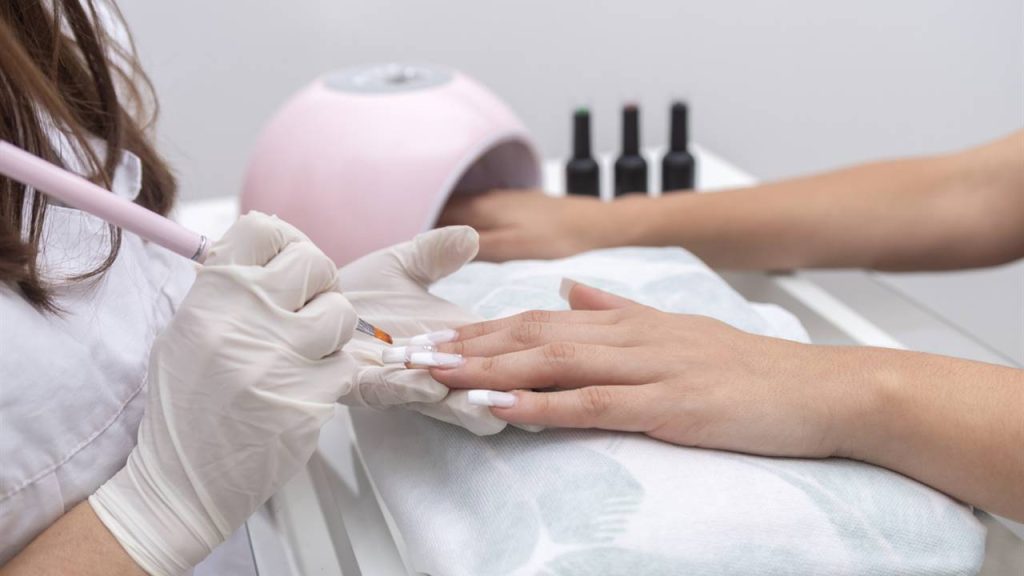It has been scientifically proven that frequent application of gel nails can be harmful. We explain the health effects of shellac and gel manicures and what more natural alternatives exist.

Shellac and gel nails are two popular techniques in manicure. In both cases, gel or varnish is applied to the nails, which then hardens with the help of ultraviolet light. This makes the color stand out and last longer.
SHELLAC NAILS AND GEL NAILS
In the case of gel nails, the gel layer applied is significantly thicker than in the case of shellac. The shellac technique, on the other hand, uses a mixture of gel and nail polish. This layer is barely thicker than conventional nail polish.
Nail salons usually recommend shellac for short nails and a more natural look. Gel manicure, on the other hand, is more suitable for longer nails that you want to shine brightly.
While both techniques are popular, both shellac and gel nails are not without harmful substances. These can be dangerous not only for nails but also for overall health.
ARE SHELLAC AND GEL NAILS HARMFUL?
Scientific literature shows that shellac and gel nails are harmful. This is due to the ultraviolet light used, which is used to dry the gel and varnish layer.
Ultraviolet light can severely damage the skin, cause it to age prematurely, and promote the development of skin cancer. The extent to which these consequences actually occur depends on the intensity of the UV lamp in question and the time of exposure to its light.
An American study shows that UV lamps can have different intensities depending on the nail salon. The risk to consumers is difficult to assess. However, the researchers note that people who only get the gel or lacquer manicure at longer intervals don’t have to worry.
Your risk of skin cancer increases if you fix your nails once a week or several times a month and are exposed to ultraviolet light for about 10 minutes each time.
However, dermatologists emphasize that each source of UV can increase the risk of skin cancer. Scientists recommend protecting your hands from UV rays with sunscreen.
HARMFUL TO SKIN AND NAILS
Shellac and gel nails are also harmful to the nails and surrounding cuticles. At the beginning of the manicure, the nails are sanded so that the gel and varnish can penetrate better, this can lead to minor injuries. In the worst case they can develop into a bacterial or fungal infection or inflammation of the nail bed.
A study on the prevalence of fungal infections in natural and artificial nails showed that the use of artificial nails was linked to a higher prevalence of fungal nail infections. Specifically, 47.1% of people who had used artificial nails had fungal nail infections, compared to 30.4% of people who had never used artificial nails.
The study also revealed that the most common type of fungal infection in the nails was onychomycosis, which is characterized by a thickening and discoloration of the nail. Onychomycosis can be difficult to treat and, in some cases, may require removal of the affected nail.
The harsh chemicals present in false nails and gel are also harmful because they dry out the nails, causing them to become much more inelastic and this leads to them becoming brittle.
SHELLAC CAN CAUSE ALLERGIES
Shellac is a type of natural resin that is produced from the secretions of an insect called Laccifer lacca, which is mainly found in India and Thailand. Due to its tough and durable properties, shellac has been used for centuries as a protective coating for furniture, cosmetics, food and pharmaceuticals.
However, according to an article published in Actas Dermo-Semibiographical, several recent studies have identified shellac as a problematic allergen that can cause allergic reactions in some people.
The reason shellac can cause allergies is because it contains a protein called aleuritic acid. When aleuritic acid comes into contact with the skin, it can trigger an allergic response in some sensitive people.
If you suspect you’re allergic to shellac, it’s important to talk to your dermatologist to get an accurate diagnosis. If you are confirmed allergic to shellac, the best way to avoid allergic reactions is to avoid contact with the allergen.
ACRYLIC NAILS AS AN ALTERNATIVE?
Acrylic nails are less harmful than gel nails in relation to cancer risk. Ultraviolet light is not used with the acrylic method. Instead, the mixture of acrylic powder and liquid will air dry. But methacrylate powder can irritate nails and skin and cause contact allergies. This leads to redness, pimples and itching.
CARE TIPS FOR HEALTHY NAILS
If you do not want to do without shellac or gel nails despite the health risks, you should follow some tips when getting a manicure:
- Don’t use hairspray or gel nails all the time, give your skin and nails enough time to regenerate. This way you will not only avoid brittle nails, but you will also not expose your skin to ultraviolet light again and again.
- After a gel, acrylic or shellac manicure, be sure to regularly care for your hands, especially cuticles and nails.
- Nail polish from certified brands of natural cosmetics is recommended as a healthier alternative to artificial nails.
WHAT REALLY HELPS AGAINST BRITTLE NAILS?
- Avoid wet work, wear gloves for dishwashing and cleaning, and use detergents and mild cleaning products, preferably with a natural or green certification.
- Avoid hardening paints and harsh chemicals.
- Apply hand cream to your fingers and nails every day.
- Olive oil provides nails with hydration, vitamins and minerals and, in combination with disinfectant tea tree oil, is an excellent home remedy for brittle nails. Mix a teaspoon of olive oil with a few drops of tea tree oil and apply it on your nails for half an hour. Then rinse with a little water
- Eat a varied and balanced diet and avoid nutrient-poor prepared meals as much as possible.



